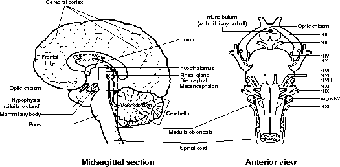Anatomy and Physiology: Thalamus: The Switching Station
Thalamus: The Switching Station
You have so far learned about the spinal cord, the cerebrum, and the cerebellum, so it's time to learn about what connects these sections. Just below the cerebrum, and above the brainstem, is the diencephalon, which is made of the hypothalamus (our old friend from the endocrine system), and just above it, the thalamus. Just by looking at the location of the cranial nerves, it is clear that the thalamus is crucial in terms of transmitting sensory impulses to the cerebral cortex.
It turns out that a tremendous amount of sensory information is transmitted to the thalamus every second. One of the jobs of the thalamus is to filter out the majority of it and only send on what is necessary to the primary sensory cortex. Think about it. Does the skin on your back sense the clothing against your skin? I bet you hadn't really noticed before. Remember the feel of clothing against your skin after going swimming, and you get a sense of how the thalamus has to decide when the stimuli are important enough to take notice. In addition to the relay of sensory information, the thalamus also relays information about emotions from the hypothalamus to the frontal cortex.
As for the hypothalamus, it turns out that it does a little more than just crank out regulatory hormones (see Hormones). All of its functions are at least partially autonomic, for both the thalamus and hypothalamus function on a subconscious level. The hypothalamus regulates such things as causing a smile when you are amused (have you ever tried to keep a straight face when telling a joke?), heart rate, blood pressure (with the pons and medulla), and body temperature, to name a few. In addition the hypothalamus coordinates voluntary and involuntary functions, which is why we can feel nervous about an event that is yet to happen. The hypothalamus also produces some emotions, as well as giving you the basic drives of hunger and thirst. That's one busy little sucker!
Brainstem and Beyond
We're down to the last of it, the brainstem! Just under the diencephalon are the mesencephalon, the metencephalon (pons and cerebellum), and the myelencephalon (medulla oblongata). The mesencephalon, or midbrain, is mainly involved in transmitting impulses from one area to another, but it also controls certain involuntary activity of muscles, such as muscle tone and posture, as well as helping to maintain consciousness.
Standing right in front of the cerebellum and the fourth ventricle, the pons (half of the metencephalon along with the cerebellum) transmits impulses here and there, in particular with the cerebellum. The pons is also involved in aspects of the regulation of breathing.
All that's left is the oldest section of the brainstem, the myelencephalon, or medulla oblongata. More relays happen here. If you have a hard time keeping track of what cranial nerve attaches where, just look at Figure 20.8, and you can learn about the nerves by looking here for the Roman numeral, and comparing that with the table on the cranial nerves in The Nervous System. As you would imagine for such a primitive area of the brain, it controls such basics as heart rate and respiration. Much of this autonomic control is due to the connection of the N X, vagus nerve.

Figure 20.8The regions of the brainstem, and the location where it branches into the cranial nerves. (LifeART©1989-2001, Lippincott Williams & Wilkins)

Excerpted from The Complete Idiot's Guide to Anatomy and Physiology © 2004 by Michael J. Vieira Lazaroff. All rights reserved including the right of reproduction in whole or in part in any form. Used by arrangement with Alpha Books, a member of Penguin Group (USA) Inc.
To order this book direct from the publisher, visit the Penguin USA website or call 1-800-253-6476. You can also purchase this book at Amazon.com and Barnes & Noble.
